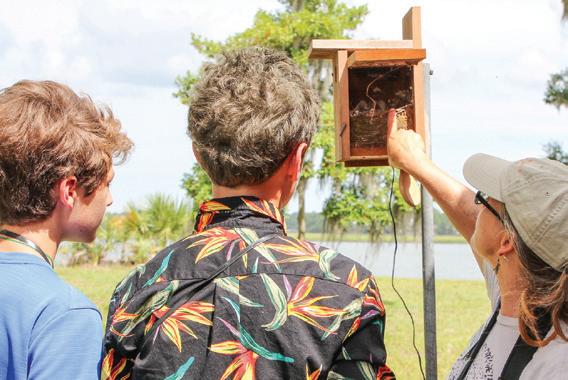
2 minute read
Monitoring Coastal Nest Boxes
By Emily Kenworthy Public Relations Coordinator
UGA Marine Extension and Georgia Sea Grant
Advertisement
With a pair of binoculars and data sheets in hand, Beth Webster heads out the back door of the UGA Marine Education Center and Aquarium to her first stop, a wooden nest box just outside the facility. She walks up to the box, gently knocking a few times so as not to alarm any birds, before opening the door to peer inside.
Four Eastern bluebird eggs, no bigger than peanut M&Ms, are nestled inside among twigs, grasses and pine needles. She records her observations on her data sheet before heading to the next box.
Webster is one of five aquarium volunteers participating in UGA Marine Extension and Georgia Sea Grant’s bird nest box monitoring program on Skidaway Island. The program involves tracking the nesting and breeding behaviors of common birds, including Eastern bluebirds and Carolina chickadees.
Between March and August, members of the group take turns checking the small circuit of boxes on the UGA Skidaway Marine Science Campus. They collect data on nesting activity, noting failed and successful nesting attempts, and submit their data to NestWatch, a nationwide nest-monitoring program designed to track status and trends in the reproductive biology of birds.
UGA educators have maintained a nest box trail on campus for more than a decade. Katie Higgins, marine educator and volunteer coordinator, decided to establish a more robust community science effort in 2019 with the goal of engaging aquarium volunteers in scientific research and increasing awareness of bird populations on the island.
“Community science is a really useful way to collect broader data on common birds,” said Higgins. “Scientists have access to this data so they can have basic information on developmental time periods and species prevalence. They can also look at longterm trends, like shifts in [population] range or when nesting is beginning in an area and when it’s ending.”
Information gathered through community science can also inform conservation efforts and management decisions. The Eastern bluebird is a prime example of this. From 19201970, the number of bluebirds in the U.S. plummeted due to habitat destruction, pesticide use, an influx of domestic cats and competition with non-native birds for nesting space.
In response, community members formed the North American Bluebird Society and set up bluebird boxes, creating networks of trails and monitoring bluebird nesting success. Because of these efforts, Eastern bluebird populations have rebounded and even stabilized.
In 2021, Higgins received funding from the Georgia Ornithological Society to expand the nest box monitoring program and develop a new educational display at the UGA Aquarium focused on community science and bird conservation.
She recruited and trained more volunteers and increased the number of boxes on campus with support from Skidaway Audubon. During last year’s nesting season, six volunteers gave 38 hours of service to the effort. In total, the group documented 28 nesting attempts and 74 baby birds.
“It’s really a magical experience,” said Webster. “You’re in nature, you’re watching the cycle of life really unfold in front of your eyes. From the birds building a nest to the baby birds fledging, it’s a privilege to be able to peek into their world and see this cycle of life that happens so incredibly quickly.”
As part of the new educational display, aquarium visitors will be able to witness the nesting process in real time thanks to a live camera feed. The exhibit also provides information about birds that commonly nest in coastal Georgia and ways to support bird conservation efforts.
“I hope visitors take away that birds are fascinating and easy to observe,” said Higgins. “There are lots of local organizations that are working with bird species, and they can do something to enhance habitat or add to greater scientific knowledge.”










